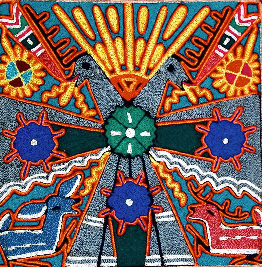

THE HUICHOL CULTURE OF SHAMANISM (1)
Taken from this site - please visit:- Peyote.com
The Huichol People of central Mexico still follow the age-old shamanic ways of their ancestors, an unbroken wisdom-bridge stretching back into the Paleolithic. The "mara'akame" the shaman, still leads pilgrims on a yearly journey retracing the path of the Gods and Goddesses when they first appeared in this middle world and traveled on sacred pilgrimage to find its center.
The Pilgrimage culminates in a night-long ceremony around "Tatewari", Grandfather Fire, a meditative retreat during which shamanic ceremony induces a visionary state by which the Huichol People find their lives and the power, the "kupuri", to follow their heart path to completion. Their distinctive visionary art, in the form of yarn paintings, embroided clothing, bags, beaded gourds, masks, jewelry, and sculpture, all derives from their shamanic visions whose symbols form the basis of their work and their lives.
The work is all hand-made by individual artists who are taught by their elders, and who then pass on the artistic techniques to their children. And so it goes, from generation to generation. Originally all the art work was made as "offrendas"prayer offerings to the Spirits left at places of power along the Pilgrimage route. This practice is still continued, but now some of the art is made to sell to interested parties who value the Huichol Path.
These are the most important symbols for the Huichol. They represent a culture in transition from hunting and gathering strategies to that of a sedentary agrarian lifestyle. The deer holds the intimate role of symbolizing the Huichol people. The character of the Huichol as a group tends to be light, flexible, and humorous. They have avoided open warfare, neither fighting against the Spanish nor for the Mexican government, but have always maintained their traditions and freedoms. They call themselves Wixalika which means prophets or healers.
The Peyote cactus is the centerpiece of their sacred ritualism. It is the vehicle by which they obtain their mystical union with the gods. It has been revered for centuries by the Huichol for its curative properties and its ability to "enlighten" the one who partakes of it.
The Huichol do not have a word which corresponds to what we of the Western tradition have called hallucination. Our definition of the word would be unthinkable for a Huichol who knows nothing of such foolish terms concocted by a paranoid establishment and its "paid for" psychologists. The flow of sacred imaging through the mind's eye is always present within the individual as can be seen by the various ways of accessing it around the world through shamanic, religious, meditative and various forms of physical manipulation and chemical means. The Huichol have practised this way of seeing beyond the normal physical realm for eons and live in communal balance long before the Europeans arrived with their chains.
The Peyoteros, as they are called, perform a pilgrimage yearly to obtain the magic cactus from the scorching desert of San Luis Potosi. This sacred place they call Wirikuta or the "Field of Flowers" is hundreds of miles from their traditional homeland.
The cactus is eaten by young and old alike. With the direction of the shaman and the support of the group, each Peyoterò is free to transcend the limitations of their ordinary sensory perceptions and see with the mind's eye, the heart of the great spirit, the interconnectedness of all things seen and unseen.
The Images expressed in their artwork are always representing stories, legends of their mythology that organize every aspect of their world and lives. The basis of their rituals are the songs of the Shamans (Marakame) and the main one says:- If you have been made of corn (eekoo) and you eat the peyote (heekoori) - the cactus that is the real core of the corn - you become the Jaguar (maye), that hunts your deer (maxra) - that is your own spirit - and listen to the song of the oldest and biggest deer (Tamatz Kauyumari) - who gives you the power - and Scorpion (Terooka) and the feather sticks (Moowieri) to heal, sing and dance.
The geometric intricacy of their art reflects the patterns of primordial archetypes present within each of us. Their art is a literal physical translation of imagery seen during their expanded state of awareness, induced by their sacred cactus. This art is a tangible manifestation of their experience in the realm of the gods for each of us to see, touch, and commune with, becoming vehicles for our own contemplation and transformation.